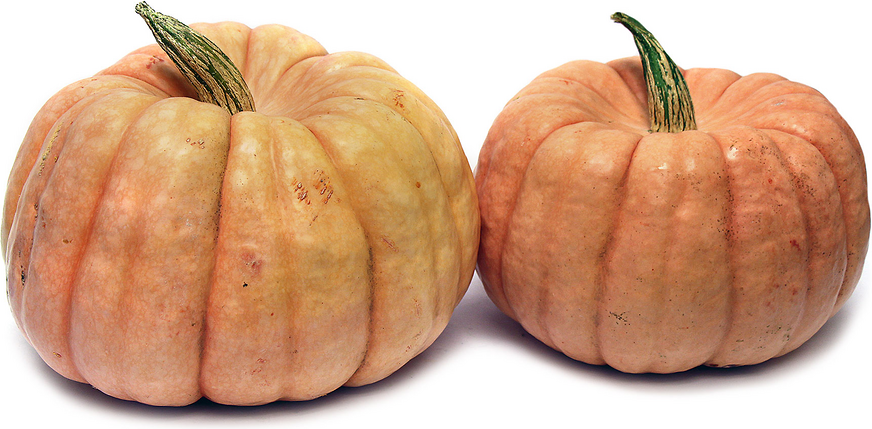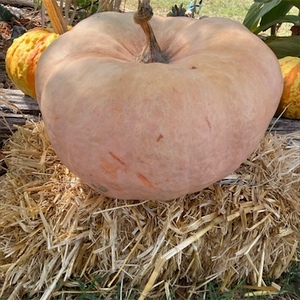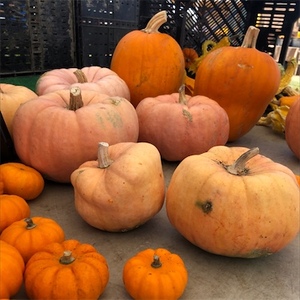


Pink Pumpkins
Estimated Inventory, lb : 0
Description/Taste
Pink pumpkins are medium to large in size, averaging 16-24 pounds, and are globular, blocky, and have a shallow, sunken in stem cap with a sturdy, cork-like, brown stem. The smooth rind is deeply ribbed with defined lobes and transforms from a pale yellow to cream, and then a pink-salmon hue when mature. The thick flesh is deep orange and surrounds a central cavity containing fibrous pulp and many flat, cream-colored seeds. When cooked, Pink pumpkins are tender with a smooth texture and a sweet flavor.
Seasons/Availability
Pink pumpkins are available in the fall through early winter.
Current Facts
Pink pumpkins, botanically classified as Cucurbita maxima, grow on a sprawling vine and are members of the Cucurbitaceae family along with squash and gourds. Also known as the Porcelain Doll squash, Pink pumpkins are an intentional proprietary hybrid created by a DP seeds, a company specializing in hybrid development. Pink pumpkins are favored for their sweet flavor, tolerance to powdery mildew, and unusual color. After seeing the striking pink color of the new variety, the company's president also decided it was the perfect candidate for fundraising efforts during October for breast cancer awareness. The Pink Pumpkin Patch Foundation was created and is a nationwide breast cancer prevention campaign that is run at the same time as when the pumpkins are in season.
Nutritional Value
ink pumpkins contain vitamin A, vitamin C, iron, and calcium.
Applications
Pink pumpkins are best suited for cooked applications such as roasting, baking, sautéing, and boiling. They can be roasted to make soups, casseroles, and stews, or pureed for use in baked goods such as cheesecake, cupcakes, pies, bread, tarts, muffins, and other desserts. They can also be cooked and used for canning, gnocchi, pasta, ravioli, bisques, hummus, and lattes. In addition to the flesh, the seeds are also edible and can be roasted and salted as a snack. Pink pumpkins pair well with onions, garlic, shallots, black beans, red kale, zucchini, quinoa, rice, green beans, spices and herbs such as cinnamon, yellow curry powder, hatch chile powder, rosemary, sage, thyme, potatoes, coconut milk, peanut butter, sunflower seeds, and roasted peanuts. They will keep up to one month when stored whole and unwashed in a cool and dry place. If refrigerated, Pink pumpkins will keep up to three months.
Ethnic/Cultural Info
The Pink Pumpkin Patch Foundation has donated over $100,000 in grants to different cancer research stations since its inception in 2012. When pumpkin growers decide to cultivate Pink pumpkins, they sign a pledge to donate twenty-five cents of their sale to the nonprofit foundation. Pink pumpkins have become a symbol of unity and are often displayed on front porches to invite others to support the cause to find a cure.
Geography/History
Pink pumpkins were developed by DP Seeds in Yuma, Arizona and were released in the United States in 2011, but they actually debuted in the fall of 2012. Today Pink pumpkins are available in limited quantities through farmers markets, online seed catalogs, and specialty grocers in the United States and Canada.










